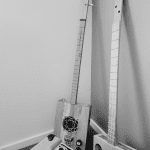

With that in mind, the tuning of the cigar box guitar lends itself to easy Blues playing. After all, the open strings (and therefore the barre chords of the three string cigar box guitar) are just an open power chord.
So all that is just a longwinded introduction to say that playing the Blues on the three string cigar box guitar is very easy. In this lesson I’ll go through some basics on how to do it and have you strumming away in no time.
The Basics Of The Blues On The Cigar Box Guitar
Your typical 12 bar Blues is based on a progression around the I, IV, and V chords. There are countless variations on this, but if you know the I chord, the IV chord, and the V chord, you can play a simple or basic Blues; whether that’s on the six string or the three string guitar.
While a lot of Blues playing uses a shuffle rhythm (which I’ll get to), start by learning chords on the cigar box guitar.
A Few Different Ways To Play I, IV, And V Chords On The Cigar Box Guitar
Let’s start with the absolute basics here: where to find the I chord (the root), where to find the IV chord, and where to find the V chord. As this is the basics, we’ll do all of this in open position. Once you get your head around the three string cigar box guitar, you can venture out into other keys.
*Note: I’m not going to talk about a specific key here. Cigar box guitars don’t really have a “standard” tuning. Take a look at my how to play cigar box guitar article for tunings and basics, but basically, while a three string guitar is typically tuned in an open power chord, the root note may be different from guitar to guitar. Because of this, it’s easier to just use the chord number.
Playing The I Chord On A Three String Guitar
This is perhaps the easiest chord to play because simply playing all the strings open is your I chord here. So do that! Now you’re strumming a chord. Easy!
An alternative to this is to invert the chord and put the root note in the middle with the 5th degree of the scale on the outside string, playing a chord like this:




To play the I chord like this, you’ll want to move up to the 5th fret. You first finger goes on the 5th fret (on the second string) and your second and third fingers go on the second fret.
While it’s obviously easier to just strum all the strings open, sometimes it’s easier to change between chords without having to shift position, or you may want to add some flavour.
Playing The IV Chord On A Three String Guitar
The fourth degree of the scale occurs on the 5th fret of the guitar. Because of this, if you’d like to play the IV chord, all you need to do is do a barre across all three strings on the 5th fret. Then you’re playing the IV chord!
There are some alternatives to this though.
Firstly, you can you the shape mentioned previously to play the IV chord on the 10th fret. This is quite a lot of movement, but you may like it.
Another alternative to this is playing a full chord (with the 3rd) Like this:


The root of the chord will still be on the 10th fret. Also keep in mind you can swap the 1st and 3rd strings!
There are a few other ways you can play the IV chord, and I’ll mention this in the next section of this article.
Playing The V Chord On A Three String Guitar
Finally, it’s time to play the V chord on the three string cigar box guitar!
Again, you can just play the barre if you like. You can do this on the 6th fret of your guitar. But that might get a bit boring quickly.
Since the 5th degree of the scale occurs naturally on the open middle string, you can use this chord shape (that I mentioned earlier) to easily play it.




However, instead of fretting the middle string, let it stay open. Then put your second and third fingers on the 2nd fret.
Putting It All Together
So we have our I chord, we have our IV chord, and we have our V chord. Practice those chords and get used to them. From there, it’s just a matter of moving between them.
Keep in mind that most Blues progressions only use the V chord as a turnaround, so don’t just go and play chords in a random order and call it the Blues. With single strums try:
I-IV-I-IV-V-IV-I
Do that a few times until you’re used to the changes, then start to add a bit of rhythm. A common 12 bar Blues pattern is to play each of the chords listed above for two bars, except only play the V chord for one bar and the following IV chord for one bar. Practice this with a basic rhythm.
Then you’re playing the Blues!
Adding Flavour To The Chords
These chords are all well and good, but they’re not the Bluesy.
The first little tip is to not just play the barre versions of the chord. It may be good when you’re first starting, but you’ll get bored quickly.
Hopefully you will have noticed that the shape below (which I’ve mentioned a couple times!) puts you right in the middle of the fretboard, making it easy to go from the I to the barre version of the IV or the V. This can be fun and easy.




To add a little more to things, especially on the IV and V chords, you can easily play 7th chords. These are just like your normal barre chords, but you add a flat 7 to the mix. It’s a great Bluesy sound!






In some ways, I found these chord shapes easier than the barre versions, and they make moving between chords a lot easier!
Basic Blues Comping
A basic Blues comp is also easy on the three string cigar box guitar. My software doesn’t let me do a tab for a three string guitar, but you can get the idea using a six string tab. The tab below shows a basic Blues comp for the I chord in the first bar, the IV chord in the second bar, and V chord in the third bar.


If you’d like something slightly more interesting (very slightly), try this comp.


As mentioned, the first bar in both tabs is for the I chord, the second bar is for the IV chord, and the third bar is for the V chord.
Obviously don’t just play those three bars over and over. Instead, use each bar in the correct place for a basic 12 bar Blues pattern.
Now Go And Play The Blues On The Cigar Box Guitar
That’s just the basics of playing the Blues on a three string cigar box guitar. The Blues can be as simple or as complicated as you want to make it, but you also need to start somewhere!
Get comfortable with these basics and you can grow by adding some three string Blues licks around chords, have more interesting comping, or a mixture of the two.
That being said, while these are the basics, you can still use them to play almost any Blues song. So practice, then go from there!



